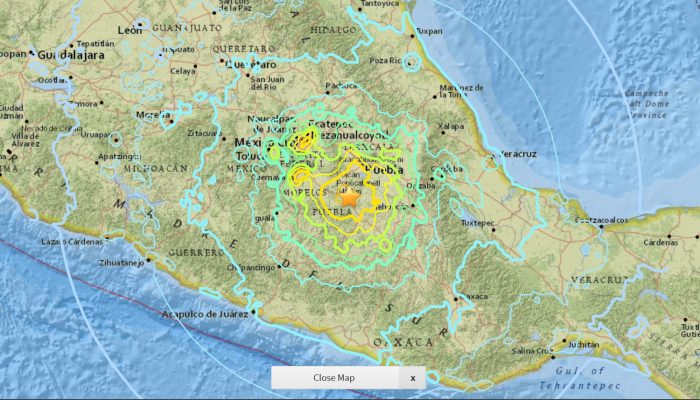On Friday 8 September 2017 at 04:49 am UTC, a magnitude 8.1 earthquake hit off the coast of Mexico, 87 km SW of Pijijiapan. According to the U.S. Geological Survey, the epicentre was at 15.07 N, 93.72 W at a depth of about 69.7 km. Yesterday, another strong (magnitude 7.1) earthquake hit central Mexico, 55 km SSW of the city of Puebla and 120 km south of Mexico City.
Despite the lower magnitude, yesterday’s earthquake, which struck at a depth of 51 km, has caused widespread destruction. At the time of writing, official estimates put the death toll at 217 (according to Mexico’s National Coordinator for Civil Protection, Luis Felipe Puente), with shaking causing damage to and the collapse of hundreds of buildings in Mexico City and surrounding areas.
“The M 7.1 earthquake was much closer to Mexico City, a city build on a dried lake bed; this caused presumably (needs to be confirmed by data) much higher shaking in the densely populated capital then the larger, but farther M 8.1 event,” explains Martin Mai, President of the EGU’s Seismology Division.
“Both earthquakes were intraplate normal faulting events, not occurring on the interface between the subducting and overriding plates but rather inside the subducting plate,” adds Vala Hjorleifsdottir, a researcher at the National Autonomous University of Mexico.
These intraplate earthquakes generate relatively strong and rapid shaking, compared to their counterparts breaking the plate interface. Furthermore, as the waves are generated deeper in the Earth, they do not travel through shallower material that damp them as they travel, and they are still strong when they arrive to the City of Mexico and neighbouring areas. For these reasons, combined with their proximity to populated areas, these events can be more destructive than expected by their magnitude.
The U.S. Geological Survey estimated that significant causalities are likely in the region. Given the mix of vulnerable and earthquake resistant structures, the economic loss is also expected to be high. For more information visit impact pages of the event on the USGS website.
Six days after the latest earthquake, rescue workers are still search for victims among the rubble. This visual of Mexico City gives an impression of the scale of the devastation in the country’s capital city.
“Mexico City [is] built on a dried-out lake bed, or on ‘landfill’ of unconsolidated sediments. The interaction between the incoming seismic waves and the sediments cause the waves to amplify and the duration of shaking to increase. Both of these factors are devastating to buildings,” explains Hjorleifsdottir.
As to whether the two earthquakes are linked, scientists are fairly certain that the normal mechanisms which are known to trigger an earthquake after another didn’t come into play for the M 8.1 and the later M 7.1. At more than 600 km between the two quakes, they occurred, too far from one another. In addition, if shaking from an early earthquake is going to trigger a second, it is expected to happen shortly after the initial tremor, not 12 days later.
However, there are other mechanisms, which are less well understood, for example the triggering of earthquakes in hydrothermal areas and volcanoes, over large distances, for a period after large events.
“We believe this has to do with the behaviour of fluids in these areas, that promote the occurrence of earthquakes in these regions. More research is needed to tell whether any of these other methods caused triggering of the second event,” says Hjorleifsdottir. Mai also adds: “It could be that stress changes caused by the M 8.1 event brought the fault (system) on which the M 7.1 earthquake happened closer to failure; but this requires detailed quantitative analysis”.
Editor’s note: Last updated 02.10.2017. This post will be update as more information about the earthquake becomes available.
With thanks to Martin Mai (EGU Seismology Division President), Vala Hjorleifsdottir, Paco Sánchez and Marco Calo (National Autonomous University of Mexico).
Further reading and resources:
U.S. Geological Survey overview of 19.09.2017 M 7.1 earthquake (includes interactive, shake and regional information maps)
U.S. Geological Survey overview of 08/09.2017 M 8.1 earthquake (includes interactive, shake and regional information maps, as well as finite fault results and moment tensor information)
Temblor blog post on M 7.1 earthquake
Temblor blog post on M 8.1 earthquake
Did Mexico dodge a bullet in last week’s M=8.1 earthquake? (Temblor blog post on dynamics of 8th September quake)
European-Mediterranean Seismological Centre information about yesterday’s earthquake
SSN (Mexico) page about yesterday’s earthquake (in Spanish)
GFZ GEOFON Global Seismic Network event page for yesterday’s earthquake
Mexico City, Before and After the Earthquake (New York Times visualisation)
Are Mexico’s two major earthquakes related, and what could happen next? (Temblor blog)
Shocked and shaken to the ground: An eyewitness report from Mexico City (Temblor blog)
Mexican Earthquakes: Chain Reaction or Coincidence? (Temblor blog)


Yvonne Chasukwa Mwalwenje
We mourn with the people of Mexico… That’s terribly sad.